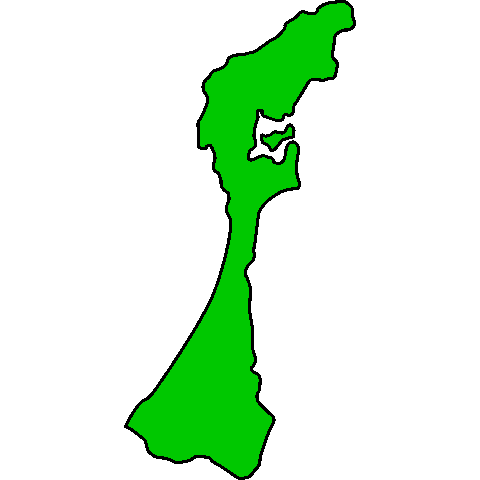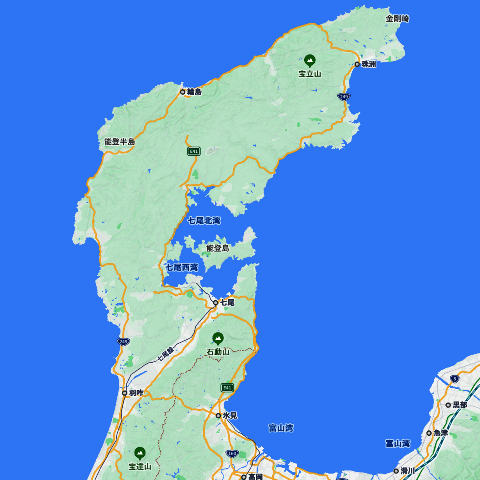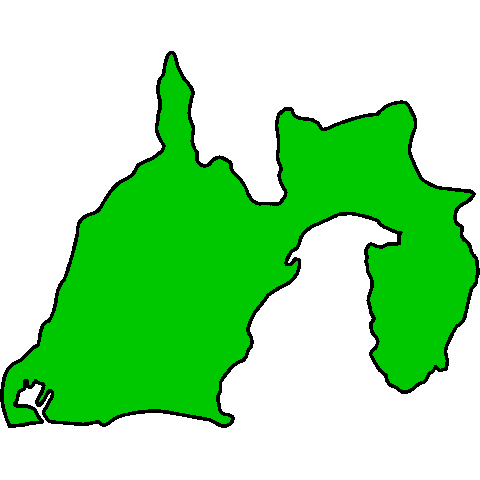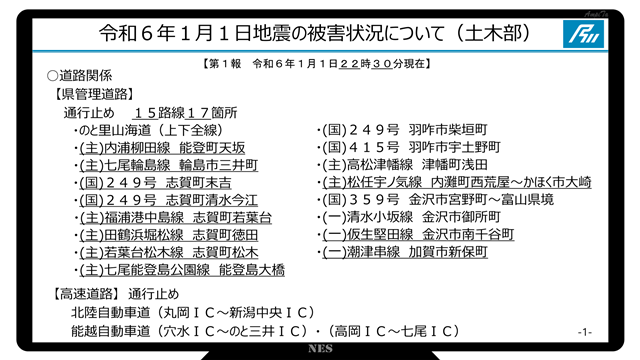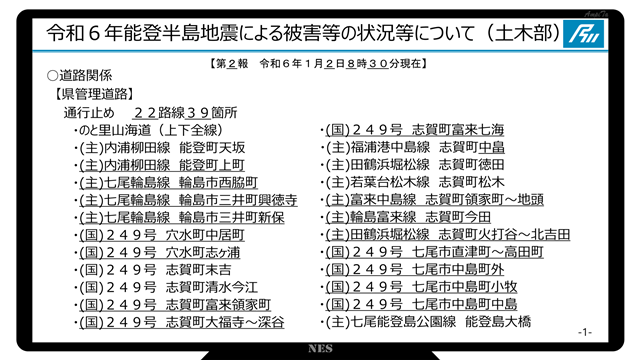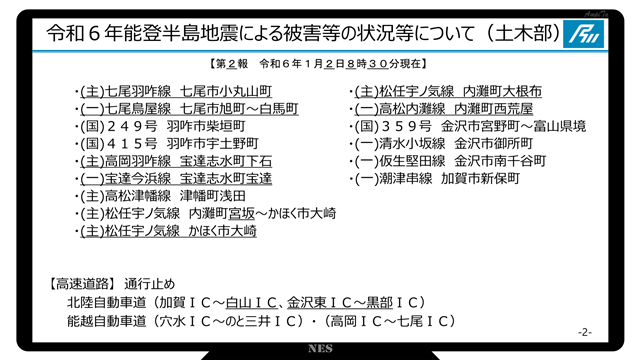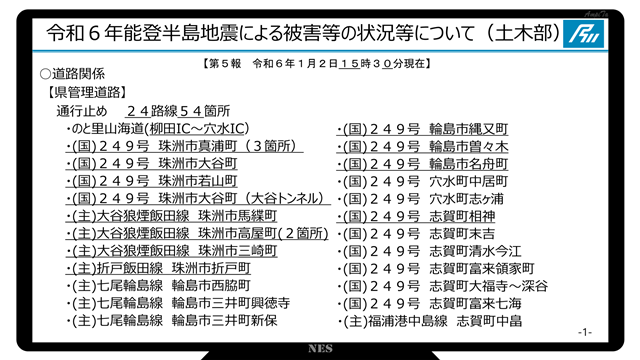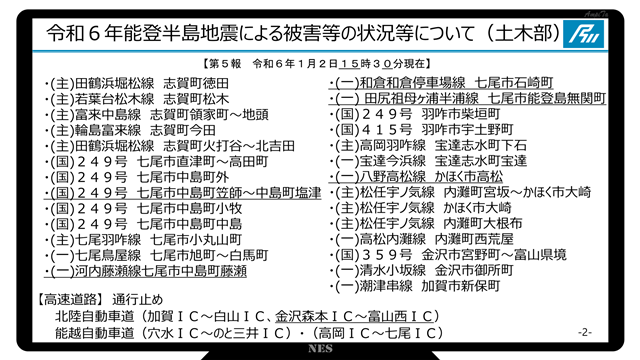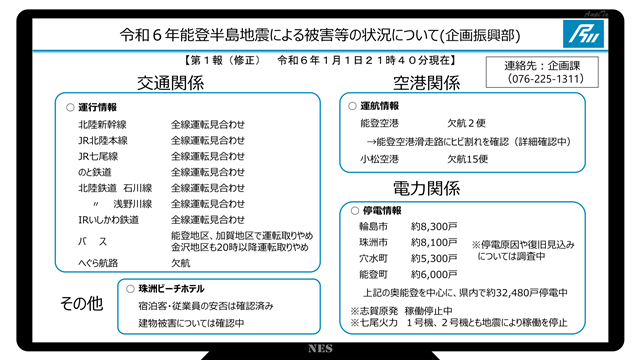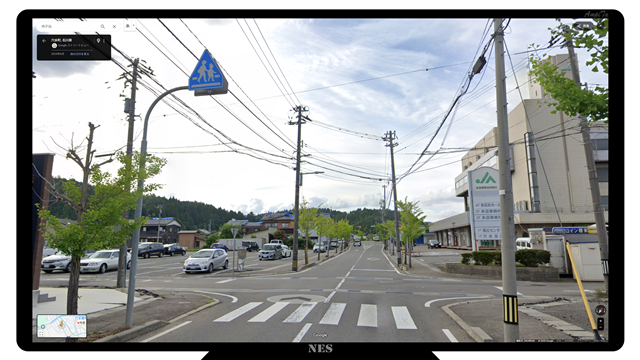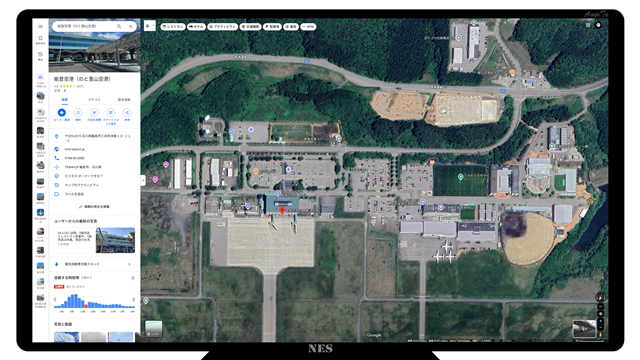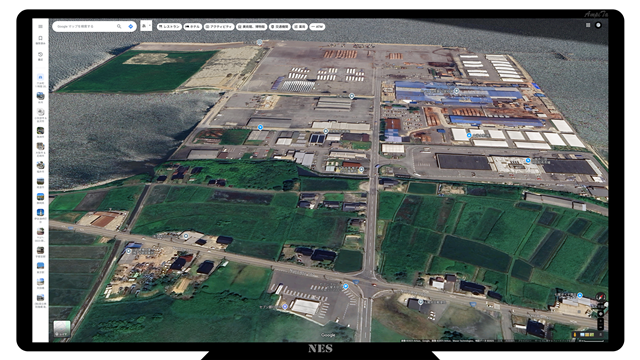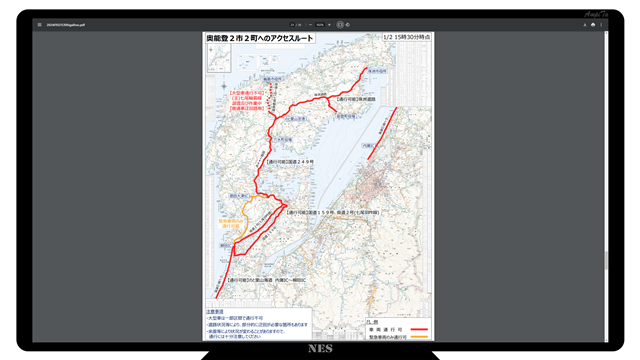On New Year’s Day this year, there was a big earthquake on the Noto Peninsula, Ishikawa Prefecture, Japan
In the Noto Peninsula earthquake in Reiwa 6th year, it seems to be the digital era, and various information was released early, so it became possible to perform various analyses in the follow-up.
This time, I would like to dig deeper into the steps of strategy and tactics.
Governor Hase said, “Once again, I would like to work together with the government to respond.”
The speciality of time.
The Great Hanshin-Awaji Earthquake struck early in the morning on Tuesday, January 17th, and the Great East Japan Earthquake occurred at 14:46pm on Friday, March 11th, and the Kumamoto Earthquake occurred at 21:26 on Thursday, April 14th and Saturday, April 16th.
In both cases, schools and companies were not on vacation, and society was proceeding as usual.
The Noto Peninsula earthquake occurred around 6pm on New Year’s Day, and many people were on vacation, and it was a time when people who went out with accommodation such as homecoming and traveling were peaking throughout the year.
In addition, it was also a time when it was easy to assume the peculiarities of daily life, such as people who usually do not drink and drink.

The speciality of the city.
This time, it is a disaster that occurred on the north side of Ishikawa Prefecture, at the end of the peninsula.
It is more than 100km from Kanazawa, the prefectural capital of Ishikawa Prefecture and is widely known nationwide, to Wajima City, and in Suzu City it is about 150km.
From Tokyo Station to Maebashi, Utsunomiya, and Mito, it is as far as Kanazawa → Suzu, but the roads are not so developed. In Kansai, I think that from Kobe Sannomiya to Okayama and Maibara.
The population of Ishikawa Prefecture is 113m people in the census, and in Kanazawa City, there are 46 million people, so about forty percent are Kanazawa citizens.
The prefectures with a population close to Iwate Prefecture (121 million people), Aomori Prefecture (123 million people), Oita Prefecture (112 million people) and Miyazaki Prefecture (107 million people) are close to the population. The population of each prefecture is decreasing, including Ishikawa.
Saitama City (132million people), Hiroshima City (120m people) and Sendai City (110million people) have the same population in one city, but each city has an increasing population.
Looking at cities in Ishikawa Prefecture in population order, Kanazawa City decreased by 0.5%, Shirayama City increased by 1.0%, Komatsu City decreased by 0.7 percent, Kaga City decreased by 5.9%, and Nono City increased by 3.9 percent.
The Peninsula’s Challenges
The challenge of the peninsula is that the land route is limited.
Access to the peninsula can only be accessed in one direction, from the root to the tip side.
If there is no industry on the tip side, it is unlikely that the railway will go to the tip.
There are only one or two main highways, and there is a possibility that there is no highway.
The main road in Okunoto is National Route 249. It is a national road laid on a route that goes around the peninsula from both sides on the east and west sides.
There is a Nogoshi Expressway in the center. It is a car-only road that starts near Noto Airport. The expressway managed by NEXCO is one part, and this disaster area is like a free expressway managed by Ishikawa Prefecture.
The problem of the peninsula is not limited to Noto, but there is a growing sense of crisis in the Izu Peninsula.
[Reference] Nogoe Expressway
[Reference] Toyama Prefectural Road Corporation: Nogoe Expressway
Oku-no-to before the disaster
“Okunoto” refers to the northern part of the Noto Peninsula, and is around Suzu City, Noto Town, Wajima City, and Anamizu Town.
The six cities that applied the Disaster Relief Act in the Noto Peninsula earthquake in Reiwa 6years are Suzu City, Noto Town, Wajima City, Anamizu Town, Nanao City, and Shiga Town. The mayors of these six cities and towns attend the meeting of the Ishikawa Prefecture Disaster Management Headquarters every time.
I stayed away from Okunoto, but Uchinada Town suffered a lot of damage from liquefaction.
The census data is as follows in the order of the population. It’s cool compared to last time.
- Nanao City 50,300 people (-9.1%) [317.9 square km]
- Wajima 24,608 people (-9.6%) [426.2sq km]
- Shiga Town 18,630 people (-8.8%) [246.6 square kilometers]
- Noto Town 15,687 people (-10.7%) [273.4 square kilometers]
- 12,929 people in Suzu City (-11.6%) [247.2sq km]
- Anamizu Town 7,890 people (-10.2%) [183.2sq km]
The population is 130,044 people in total in six cities and towns.
Onomichi City in Hiroshima Prefecture has 131,170 people, 284.8sq km and relatively low population density, but Okunoto is a much larger area with a population of the same.
The 249th National Route, which runs through Okunoto, has a total length of 222km.
[Reference] Statistics Bureau of the Ministry of Internal Affairs and Communications: Reiwa two-year census
[Reference] Ishikawa Prefecture: General National Route No.249 Wajima Bypass
Two meetings of the disaster response headquarters on the day of the disaster
The first meeting of the disaster response headquarters of the Ishikawa Prefectural Government started at 18h30 on New Year’s Day. At this point, the governor was in Tokyo (Prime Minister’s Office), so he participates on the web.
The order of the first statement is as follows. The governor spoke for about a minute at the beginning, but the Kanazawa Regional Meteorological Observatory spoke for five minutes and forty seconds from one minute ten seconds to six minutes and fifty seconds. It seems that it was because it was biased to the Japan Meteorological Agency that it had reliable information.
- Governor of Ishikawa Prefecture
- (National) Japan Meteorological Agency (Kanazawa Regional Meteorological Observatory)
- (Prefecture) Crisis Management Superintendent
- (Prefecture) Police Headquarters
- (Prefecture) Civil Engineering Department
- (Prefecture) General Affairs Department
- (Prefecture) Board of Education
- (Prefecture) Planning and Promotion Department
- (Prefecture) Culture, Tourism and Sports Department
- (Prefecture) Ministry of Health and Welfare
- (Prefecture) Living Environment Department
- (Prefecture) Horse Racing Business Bureau
- Ministry of Commerce, Industry and Labor
- (Prefecture) Tourism Strategy Promotion Department
- Agriculture, Forestry and Fisheries Department
- (Country) Self-Defense Forces
- Japan Coast Guard
- Governor of Ishikawa Prefecture
During the first meeting, it was a disaster response headquarters meeting amid the confusion where an emergency earthquake early warning flowed in one minute 40 seconds and 10 minutes 56 seconds .
After this, I returned to Ishikawa with Mr. Koga, Deputy Minister of the Cabinet Office, and others in the helicopter of the Self-Defense Forces, and attended the second meeting of the disaster response headquarters. The second meeting is being held from 23:45 a.m.
- Governor of Ishikawa Prefecture
- (National) Japan Meteorological Agency (Kanazawa Regional Meteorological Observatory)
- (Prefecture) Crisis Management Superintendent
- (Prefecture) Police Headquarters
- (Prefecture) General Affairs Department
- (Prefecture) Planning and Promotion Department
- (Prefecture) Culture, Tourism and Sports Department
- (Prefecture) Ministry of Health and Welfare
- (Prefecture) Living Environment Department
- Ministry of Commerce, Industry and Labor
- Agriculture, Forestry and Fisheries Department
- (Prefecture) Tourism Strategy Promotion Department
- (Prefecture) Horse Racing Business Bureau
- (Prefecture) Civil Engineering Department
- (Prefecture) Board of Education
- Ground Self-Defense Force
- (Country) Air Self-Defense Force
- Japan Coast Guard
- Ministry of Land, Infrastructure, Transport and Tourism (Hokuriku Development Bureau)
- (National) Ministry of Internal Affairs and Communications Fire and Disaster Management Agency
- (National) Cabinet Office (Vice Minister Koga)
- Governor of Ishikawa Prefecture
Initially, we talked about culture.
The Ishikawa Prefectural Government has released a meeting of the disaster response headquarters on YouTube. It is almost a year since the release, but you can see that the number of views is not so much, the first time is seven thousand, the second time is four thousand, the third time is two thousand, and the fourth time is one thousand times.
You can know public assistance by knowing what kind of movement the administration will do, what can be done, and what can not be done, and you will know what you should prepare as mutual assistance and self-help with that hint.
The first time was two hours after the disaster, so the amount of information was small, but in the second time, information was gathered to some extent and each department was present, so I saw a kind of temperature difference.
Prefectural Government Building
At the second meeting of the headquarters members, the General Affairs Department took the lead in reporting from the department in the prefectural government, and reports were reported on the damage to buildings of prefectural buildings and organizations on the go, and the status of Internet connections were reported.
Prefectural officials who have to report on the scope of their own responsibility, such as “There is a big damage such as glass breaking” and “Internet failure is occurring”, so they have to report information that is not related to human life or life, I understand the heart that it will be heartbreaking.
[Reference] The 2nd Ishikawa Prefecture Disaster Countermeasures Headquarters Meeting Civil Engineering Department Report (from 7min. 50sec.)
[Reference] The 2nd Ishikawa Prefecture Disaster Management Headquarters Meeting Health and Welfare Report (13min.30sec.-) [Reference] The 2nd Ishikawa Prefecture Disaster Management Headquarters Meeting Tourism Strategy Promotion Report (16min.38sec.)
Cultural Facilities
Speaking of Ishikawa, Kenroku-en Garden in Kanazawa, but the Civil Engineering Department reported on Kenroku-en Garden and Kanazawa Castle Park.
The Notojima Aquarium was reported by the Tourism Strategy Promotion Department.
“The water level of the whale shark hall and the water level of the aquarium are now less than half the normal,” so it is related to the lives of creatures trapped in the aquarium, but there is no manpower enough to be able to dispatch the Self-Defense Forces etc. just because you hear this report, you may need to report, but I think that it is a necessary consideration issue to consider what to do that is difficult to respond to.
The Tourism Strategy Promotion Department reported on the zoo, the Insect Hall, and Tatsuguchi Kyuryo Park.
About Kanazawa Racecourse The Racing Business Bureau reported that there were reports such as “There are several cracks in the glass on the first floor of the stand building”, “There are several places around the stand building where there are steps caused by subsidence due to ground subsidence”, “The racecourse is today’s holiday and there are no human casualties”, “We have decided to cancel the release outside from tomorrow to the 5th”.
Looking at the revenue of the prefecture, the amount of revenue from the horse racing business was 289billion yen in the settlement of the Reiwa 5th fiscal year, and the remaining amount of the surplus income and expenditure ratio was 2417million yen, so the scale of the business is large, so it may be important to hold it.
[Reference] The 2nd Ishikawa Prefecture Disaster Countermeasures Headquarters Meeting Civil Engineering Department Report (19min.25sec.~)
[Reference] The 2nd Ishikawa Prefecture Disaster Management Headquarters Meeting Tourism Strategy Promotion Department Report
[Reference] The 2nd Ishikawa Prefecture Disaster Management Headquarters Staff Meeting Report of the Tourism Strategy Promotion Department
[Reference] The 2nd Ishikawa Prefecture Disaster Management Headquarters Meeting Horse Racing Business Bureau Report (17min.22sec.~)
[Reference] Ishikawa Prefecture: Outline of Ishikawa Prefecture revenue and expenditure settlement in the 5th fiscal year of Reiwa
[Reference] Ishikawa Prefecture: Reiwa 5th fiscal year Ishikawa Prefecture revenue and expenditure report
Life-saving until the second meeting
Governor Hase said, “I would like to ask you to take priority measures for water supply vehicles, especially when there is a power outage at medical institutions, or when there is a water cutout.”
At the same time, there were comments such as, “Disaster life-saving is the first twenty-four hours at the first point, so I would like you to do your utmost to gather information.”
Injured
At the second meeting of the headquarters members, the Crisis Management Superintendent said, “There is information that there are also injuries, etc., but it is said that each firefighting headquarters is cooperating and is now responding” However, it is said that the processing of the 119th report was not received in time in Okunoto.
Rescues and rescues may have fallen even further.
Emergency Fire Service
At the first meeting, the Crisis Management Superintendent said, “Emergency firefighting assistance teams have also been requested. Emergency firefighting assistance teams are now arriving from each prefecture.”
At the second meeting, “Emergency firefighting assistance team, we are requesting dispatch at 7pm, and emergency firefighting assistance teams are entering the prefecture from each prefecture.”
[Reference] The 1st Ishikawa Prefecture Disaster Management Council Meeting Crisis Management Superintendent Report (8min.50sec.~)
[Reference] The 2nd Ishikawa Prefecture Disaster Management Council Meeting Crisis Management Superintendent Report (6min.15sec.~)
Doctor Helicopter
According to the cooperation agreement between the doctor helicopters in the event of a large-scale disaster in the Chubu region, the Health and Welfare Department reported that from January 2nd, one from Nagano Prefecture and Aichi Prefecture, they plan to come to Komatsu Airport one by one from Nagano Prefecture and Aichi Prefecture, and three aircraft together with a helicopter in Ishikawa Prefecture will be transported to patients.
Medical Institutions
The Ministry of Health and Welfare reported that it was a “preparatory facility” at the second headquarters meeting, and the water supply pipes of the public Noto General Hospital were reported to be damaged.
Road enlightenment until the second meeting
In the Noto Peninsula earthquake in the 6th year of the Reiwa era, soon after the disaster, there were reports of situations that hindered traffic, such as the sinking of roads.
According to the data compiled by the prefecture in the six hours after the disaster, the road is closed at seventeen places on fifteen routes. According to the explanation from the Civil Engineering Department at the disaster response headquarters meeting, it is said that it is “closed to the road” (around 17min 50sec), so it may not be physically impossible to pass.
January 1st, 2024, 1st Report
[Reference] The 2nd Ishikawa Prefecture Disaster Management Headquarters Meeting (17min.50sec.~)
[Reference] Michi Navi Ishikawa
It is reported that the Noto Satoyama Kaido (upper and lower lines) created isolation and about two hundred people were evacuating to the service area on the way.
The Uchiura-Yanagida Line is a main road that goes to Suzu, but this is closed, which is causing great damage to access to Suzu.
The Nanao Wajima Line is a main road that goes to Wajima without facing the sea, and it is a highway, the Nokoshi Expressway, but this is closed to traffic.
It is an indispensable road topic for access to Noto Airport, but since the road is the prefectural civil engineering department and the airport is the prefectural planning and promotion department, the airport is not included in the topic from the civil engineering department.
Road enlightenment on the day after the disaster
In the second report on January 2nd, the day after the disaster, the number of traffic closures increased from seventeen on fifteen routes to thirty-nine on twenty-two routes. The report is expanded to two pages.
January 2, 2024, 2nd report
The above report was eight and a half, and the next one was fifteen-thirty, but within seven hours, the traffic was increased to 54th on twenty-four routes.
The damage situation of National Route 249 has become clear, and it seems that the passages where you can pass and the parts where you can not pass are clear.
January 2nd, 2024, 5th report
As you can see from the remarks of the Self-Defense Forces and the Ministry of Land, Infrastructure, Transport and Tourism at the disaster response headquarters meeting, it seems that there were places where the road that should have been passed due to the aftershocks could not pass, and it was possible with passenger cars because it was a big wheel, but it was impossible with passenger cars.
Power outages until the second meeting
As for the power outage, although there are reports, it is changing from time to time, and there is a relationship with road enlightenment around here, so I felt that I did not know where the accurate information was.
To the main topic of this article
At the beginning of the disaster, it was as above, but it will continue as well.
Since it is in Ishikawa Prefecture, the prefectural office is taking the lead in grasping the damage situation and restoring it, but the lack of resources is undeniable, and the state that it is asked to the government to be supplemented.
With regard to road enlightenment, I could see that the Ministry of Land, Infrastructure, Transport and Tourism and the Self-Defense Forces were working together to advance, but at the request of the prefectural governor, it seems that they provide as much resources as possible.
While looking at individual responses, we will explore the area that the tactics may have been leaking.
Decide on a location
In the Noto Peninsula, National Route 249 became an important infrastructure that can be used for all aspects of transportation, medical care, and other matters.
I think that the basic policy of the strategy will be “maintaining the passage of National Route 249 and Prefectural Road1”. In addition, I think that maintaining even one road from Kanazawa to that point will be added to the secondary policy.
The logistics base is Kanazawa
It is thought that relief from other prefectures comes from the Hokuriku Expressway, the Tokai-Hokuriku Expressway, and the National Route8. The Nogoe Expressway, which is directly connected to these roads, is a dedicated road for automobiles, and you can go to Wajima in Okunoto.
The Tonami Kotani-be junction is suitable for logistics bases, but it is unreasonable for Ishikawa Prefecture to be the base because it is Toyama Prefecture.
Kanazawa, which is the prefectural capital and has many accommodation facilities because it is a tourist destination, and Kanazawa, where you can arrive at Kotanibe Tonami JCT in 20 to 30 minutes if you go through the Hokuriku Expressway, is considered to be the best logistics base in Ishikawa Prefecture.
Secondary base
If the primary base is Kanazawa, there is more than 120km even if you use the shortest route to Suzu City Hall. If it goes through the coastal area of Wajima, it will exceed 150km.
It may be smoother to set up a base on the way than to move from Kanazawa to various places separately.
First of all, if the next base in Kanazawa is to be established within 100km, I think that Nanao City or Anamizu Town, which can be reached from both the eastern and western routes of the prefecture, will be nominated.
If you look at the lives of the prefecture, JR is the end point of the Nanao Line at Wakura Onsen Station, and from there, the north and the railway runs to Anamizu Station. If the residents north of Anamizu go to Kanazawa by train, they will use Anamizu Station or Nanao Station, so I think that Anamizu and Nanao are easy to imagine from the residents of Okunoto.
If you need personnel for logistics, you will need food, food and accommodation. In that respect, I think that there are many facilities in Nanao where Wakura Onsen is located, but since it is an area with a high customer unit price, I think that it will be from Kanazawa when it comes to business hotels with less than ten thousand yen.
[Reference] JR Odekake Net: Route Map
[Reference] and Railways: Information along the line
Containers up to secondary locations
I don’t have time to build a large warehouse as a secondary base, and I don’t think it’s possible to rent a private warehouse because it’s a place that doesn’t need a large warehouse in normal times.
If it can be maintained, I think it would be a flat land like a container yard.
If you look at the urban area of Anamizu, it seems that there is not much flat vacant land because JA has a large parking lot.
A little further north, there is an airport.
I do not know the laws related to aviation, but there are many flat areas, so there are places where it seems possible to arrange containers.
There is an industrial port in Nanao, so there is a lot of land suitable for lining up containers.
However, because of the risk of a tsunami, I think it will be difficult to use it as a base. In fact, a major tsunami warning has been issued for Nanao City, and the Nanao thermal power plant has been shut down.
If you set up a container yard somewhere, you will need a road with a 40ft container to pass through there.
For 40 feet, the container itself is about 12m long, and the chassis that carries it is about 12.5m. The entire length of the trailer towing is designed to be within 16.5m.
If the maximum load capacity is 24t, it is necessary to build a road with a design that imposes a load corresponding to the axle.
Go to the third base (city and town base)
Suppose we develop a strategy that allows container cars to pass from the first base (Kanazawa) to the second base.
From the second base to the base of each city and town, you can take a strategy to secure a road with a width of about 3m, as if you pass through a road that is narrow due to a slight step or the road shoulder collapses and narrow.
In the first and second rounds, gravel and asphalt are also transported, and it is necessary to open the road in earnest, but the second to third time is temporary, so you can focus on passing through because it is good in any form.
The Last Mile
We will consider the “last mile” from the base of the city to evacuation centers, including the method of not even using cars.
In fact, there are cases where the Self-Defense Forces have moved on foot to isolated areas, and if the information is collected, they can request a helicopter or take some action.
Procurement of civil engineering technology
As for the direction of road enlightenment, I think that it was the opening of National Route 249 and Prefectural Road 1st Route in the Reiwa 6th Noto Peninsula earthquake, which secured even one road with the affected area.
As a strategy, we were able to reduce the size of the vehicles that should be passed sequentially by dividing the logistics base into the first, second, and third rounds.
The question here is which areas, which projects, and who will be devoted to them.
The Ministry of Land, Infrastructure, Transport and Tourism, the Japan Ground Self-Defense Force, and the prefectural civil engineering department have the technology to open up roads. In addition, there are technologies such as private road construction companies, NEXCO Central Japan, etc.
I think that there are many small-scale manufacturers, rental companies that can lend heavy machinery as collaborators, construction companies with operators, building materials that can pay for gravel, etc. with heavy machinery themselves.
When the disaster response headquarters of the prefectural government leads the road enlightenment, I think that the waste machinery in the civil engineering department under the direct control of the prefectural office is not enough for the burning stone, so I will ask the outside.
If the other party is a country, they may be dispatched immediately just by requesting it, but each of them is working by law, so by applying the Disaster Relief Act etc., if it is the Self-Defense Forces, the Ministry of Defense, if it is a regional development bureau, it will be moved to the Ministry of Land, Infrastructure, Transport and Tourism.
Even if the other party is a local government, I think that it will be dispatched at the request, but it may be necessary to prepare the cost burden later. I think that will change with the agreement around here.
In the case of a private citizen, it is basically a fee.
I loaded a two-ton dump with a yumbo and went to the site with two workers and one security guard. I think that dumps and yumbos will cost 12,000 to 15,000 yen a day, that is, vehicle costs will be 24,000 to 30,000 yen a day.
The unit price of public works design labor is 23,600yen for the weighted average for all occupations nationwide. As you can see in Ishikawa Prefecture, the table below is shown. If the worker who handles yumbo is less than 3t, it is “special worker” or “driver (general)” and if it is more than 3t, it is “driver (special)”. If there are two special workers and one security guard, the accumulative value is 74,600yen. In addition to this, legal welfare expenses, labor management expenses, safety management costs, etc. are required.
It is necessary to expect about twelve to fifteen thousand yen a day as a set of labor costs and vehicle costs in a three-person group.
| Job Category | Labor unit price |
| Special worker | 28,200yen |
| Ordinary workers. | 24,000yen |
| Light worker | 18,400yen |
| Landscaping | 23,200yen |
| Homenko | 34,200yen |
| Tobiko | 30,800yen |
| Denko | 26,000yen |
| Rebar | 30,500yen |
| Steel skeletal | 30,000yen |
| Welders | 30,700yen |
| The driver (special) | 26,500yen |
| The driver (generally) | 24,400yen |
| Sakuiwako | 34,500yen |
| Tunnel Specialist | 46,400yen |
| Tunnel workers | 31,600yen |
| Tunnel caretaker | 48,100yen |
| Traffic Guidance Guard A | 18,200yen |
| Traffic guidance guard B | 16,200yen |
Due to the increase in costs, it may not be possible to pay from the municipal wallet. If you send three people to a hundred places for ten days, it will exceed one hundred million yen.
The prefectural office asks the government to pay the cost to the government, and even if you get consent, you can not use the tax of the people without permission, so you will be prepared through the prescribed procedure.
The Ministry of Land, Infrastructure, Transport and Tourism (MLIT) and the Ministry of Defense (MEXT) are required to provide heavy equipment and personnel, the Cabinet and the government are required to pay for the costs, the local government and contractors, and only the road enlightenment.
Optimization of road enlightenment strategies and tactics
Even if there are many heavy equipment and workers who are tactics, there will be waste if you do not operate the right person in the right place in a timely and appropriate manner.
For workers who want to be useful in the disaster-stricken areas as much as possible, wasteful time is not a situation where they are happy to receive a salary just by being there, wasteful time is only stressful.
From the prefectural office “Please repair this part of the road. If you ask me, I think that the construction method will be done quickly at the discretion of the site. If you follow the theory of sexual goodness, I think that you will choose a high-quality construction method in the same time.
When you have set the location, you say, “What’s the next thing?” You will need instructions.
If other people are working nearby, I have a feeling that I want to help, but I do not know if I can move without instructions.
Especially in the case of civil servants, the chain of command is clear, so it may not be possible to do it on its own.
Therefore, I believe that the person in charge of the government has full authority for road enlightenment, and for public officials, the officer in charge of the authority to lead the government with a legal basis for public officials, and the private sector has the authority to lead as an orderer, and the person in charge of the command to do so under the big instructions of “Please restore the roads in the disaster area”, even if the same instructions are different, even if the members in charge have full responsibility, I think that they will be able to restore the road in a flexible manner in a flexible manner by having the full responsibility to have the full responsibility.
If the country can move from the initial dispatch request stage, the story will be faster. Since it is a national road, I think that if we do not divide it because it is a city road, we will restore the road once in the country, and if we will consider and deal with the cost related to it at a later date, we will be able to restore it that is aimed at “opening of the road”.
Even if you look at this Noto earthquake, a part of the road with damage is reported, but it is not possible to see who, when, and how to recover it, so “I went there … ” It will mean.
When there is a plan to “let the medical team go on this route”, I think that certainty will increase if everything that is a hindrance to the route is processed under one country-designated officer.
Review of reports, contacts, and consultations
What I noticed when I saw the meeting of the disaster response headquarters members was that it was a one-sided report.
The head of the headquarters (governor) may get a plunge, but it is basically a one-way street.
Since the reports are made sequentially from each department, it is based on the work in charge.
If you are meeting with a goal-oriented approach, I think it is constructive to share information on a certain issue and find a solution.
There is a “report” that I arranged a water supply truck because it is a water supply truck because it is a water supply truck at a certain point. There is no discussion about whether the water cutoff is at the level that water trucks need, or whether there are priorities. Even if there is a failure on the route where the water truck will pass, it can only be noticed by the person who arranged the water supply truck while listening to the report.
If it is to be changed, the water supply base and supply base are shown on the map, and the traffic closure information of the police headquarters and the Ministry of Land, Infrastructure, Transport and Tourism is repeated there, and if it is expected that it is expected to be difficult to pass, we will strike an alternative measure on the spot, so I think that the certainty of water supply will increase.
I think it is better if information about traffic is pre-aggregated. This time, although it seemed that the prefectural civil engineering department was the main focus, there was a scene where the information obtained while the Self-Defense Forces were on the move was not transmitted to the Civil Engineering Department, so I could not see the information center.
Each time, you can see a scene that explains the weather information for a long time, but it makes me think that it is necessary. At least, I think it would be more reasonable to report the information you need after listening to the reports from each department.
This time, the prefectural office was able to check the weather forecast because the electricity and communication were normal. I feel like I’m not in a place to deal with that information.
Formal decapitation of training
Many of the disaster prevention drills conducted by the government according to the day of disaster prevention, etc., are carried out formally according to the scenario, and I think that it has become a dead body.
There are often cases where the police and fire department have a happy ending, showing the state of the rescue as a demonstration and saying, “The police and fire department cooperated and rescued each other across the fence.”
On the other hand, at this time, both the police and fire departments come and perform the role, so I think it is natural to succeed.
At the site of the disaster, police officers at police stations will be at the forefront, and it can be said that they can do what they can without the tools and skills of rescue.
The rescue team’s professional arrival will be a few hours or days in advance, and there will be no shortage of men arriving toward the seventy-two-hour wall.
There is also a demonstration of “I gave instructions” and “received a report” by creating something like a command headquarters, but I think that this itself has become a dead body.
Even if something is reported while the situation of the disaster is not known, I think that it is not a situation where it can be judged whether it is the tip of the iceberg or the whole picture.
“We found two rescuers and rescued them.”
“The two people who were rescued were taken to the hospital and are being treated.”
This report is only a report that one job has been completed because it is an individual case of the rescuer who was able to find it.
Required information and instructions
Both training and production are common, but it is important to be able to collect the necessary information and grasp them without leaking them.
I think that the police, firefighting, local governments, ministries, ministries, and the private sector can obtain a variety of information, but each has a different terminology and culture, and even if you provide information using the same words, there is a possibility that the meaning differs due to the difference in literacy.
I think that it is also the meaning of training to fill this gap.
It is difficult to select small information from all over the disaster area, but I think there is a meaning that it can be managed centrally.
between the wounded and medical care.
The injured may be a human, a local resident, or a foreign tourist. He is an injured person anyway.
In peacetime, it is an ambulance that transports the injured, and since it is a fire department, it is a category of public assistance.
Medical care is the treatment of the injured, and the operating mother is various, but it is some kind of corporation or individual.
In the event of a disaster, it is often written in the regional disaster prevention plan as an administrative work, but the destination handed over to a medical institution is often written as the work of a medical institution, so the details are unknown and are cleared as self-help by medical institutions.
How about thinking if this is beneficial to the people?
If you think that medical institutions are private businesses, you only need to deal with the number of injuries that can be accepted, and you do not have to forcefully accept them.
Even if you do not do it, you do not need to do it only in your own resources and prepare in advance.
Medical institutions are in the business of contributing to the provision of medical care in peacetime from their own sales proceeds.
There is no need to purchase special equipment or keep staff on standby in case of a disaster. Even if you prepare for such a situation, it does not mean that the medical fee will increase, so I think it is better to return the funds to employees.
From the patient’s point of view, even if the generator is procured, it will have no effect, but I think that the value of using the hospital will increase if the waiting room and toilet are renovated and the latest medical equipment is introduced.
I would like you to reconsider the current structure of public assistance until the patient is transported to a medical institution, and after that, it is self-help of medical institutions.
Centralization of supplies procurement
I think that the procurement of goods was well adjusted by the Noto Peninsula earthquake.
People from central ministries such as the Cabinet Office, the Ministry of Land, Infrastructure, Transport and Tourism, and the Ministry of Economy, Trade and Industry (METI) were also present at the disaster response headquarters meeting in Ishikawa Prefecture, and they were working to solve the problem on the spot.
When it was found that there were not enough temporary toilets, the head of the headquarters (governor) requested it from the Ministry of Economy, Trade and Industry, and the procurement was carried out through the network of the Ministry of Economy, Trade and Industry. Since it was delivered in small increments, I think that the manufacturer probably continued to ship the amount manufactured on that day and deliver it to the affected areas every day.
This time, the Ministry of Economy, Trade and Industry received many requests and procured them. I don’t know if it was a national tax or a prefectural tax, but it was a quick response anyway.
General Headquarters
If road enlightenment, rescue, relief, medical care, food, and supplies are centrally managed, I think that the response after the disaster will be smooth.
If there is a way to listen to requests at a certain level and in a common language, the needs of the affected areas are accurately grasped and it is easier to prioritize them.
At present, the governor of the prefecture serves as the head of the headquarters and serves as the general manager, but the governor’s authority is not directly under the direct control of any institution, but is in the position of collecting information and asking for it.
Instead, I think that if we can gather information and lead and direct, we can shorten the time lag.
Since the Prime Minister cannot play that role, I think it would be good for someone at the ministerial level appointed to play that role.
I’ll live, Commander.
The commander who actually takes command of the commander must have a network in Nagata-cho and Kasumigaseki, but he must also be familiar with the disaster-affected areas.
In addition, I think it is necessary to be good at disaster response.
Let’s say that the commander candidate is asked to take on disaster prevention work for a certain period of time in Kasumigaseki. After that, designate the prefecture in charge and issue an order to settle in the prefectural seat for a certain period of time. During the period of settlement in each region, the main workplace is the prefectural office, and Kasumigaseki is left as a workplace to follow.
At the prefectural office, I think that you can know the invisible balance within the office by knowing the work contents of each department and the personality of the chief of the office.
I think that you can have local information such as which roads are crowded, which roads are crowded, which areas have many detached houses, and it seems to be busy harvesting rice in autumn.
I think that the job of the prefectural governor is to make efforts to promote industry and improve the health of life in the prefecture, but I think that it is a job for the candidate to make the commander do not improve the prefecture, but not to make it worse by disasters.
By living in the local area, I think that it is possible to make accurate judgments in an emergency and allocate resources in the right place for the right person.
Training work
By having a candidate for commander specializing in disaster response in the office, there is a possibility that the vulnerability of the prefecture will be noticed.
In the Kumamoto earthquake, the car stay was close up, but legally, people who are evacuating arbitrarily outside the jurisdiction of the government are not provided with lunch boxes and blankets.
In Ishikawa Prefecture, staying overnight in a car was also a challenge.
Governor Hase, the head of the department, used the word “salt response” to complain about the administration’s response to the victims of the disaster victims other than evacuation centers.
Even if you still go to my house, evacuation at home, evacuation in the car (staying in the car) go to the primary evacuation center to get things, “No!” Or, “I can’t give it to you!” Or, the so-called “salt correspondence” is called “Salt correspondence”, and I get a call every day saying “What’s going on”.
The 26th Disaster Response Headquarters Meeting
I think that it probably has to be thorough at evacuation centers, etc., so I would like to ask you to come here so that supplies can be delivered to those who are evacuating at home, evacuation in cars, etc. at the site.
If we continue to respond now, we will only be concerned about the rate of arrival at the city hall and evacuation centers, which are known to have to deliver supplies, and I think that the rate of reaching the victims will be ignored.
I want you to conduct sharp training that strikes there.
If I were to plan an above-mentioned exercise, I would distribute a list of evacuation centers as the third day of the disaster, show the number of breads and onigiri that I supply every day, and show the number of bread and onigiri that I supply every day, “I will investigate some of the victims who can eat all three meals” and “How to eat the amount of food as usual for middle and high school students who are growing up to eat as usual”, etc.
If there are a hundred, I think that one of them can be used in the event of a disaster.
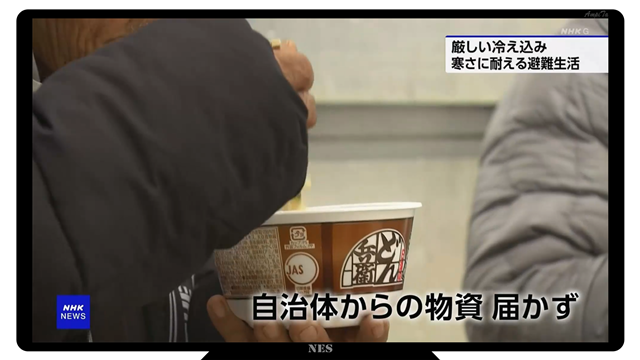
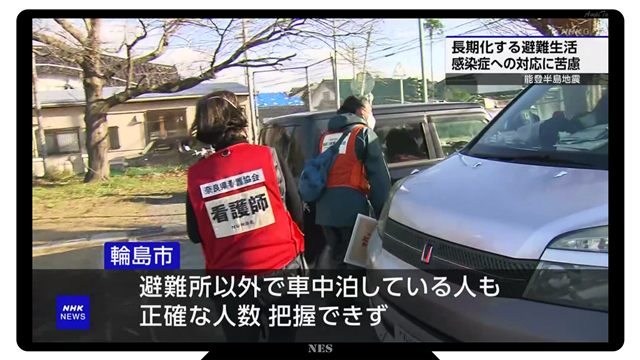
I think it takes training on difficult decisions.
In medicine, there is a process called triage, which selects patients. If you are going to save as many as possible with existing resources, you may not be able to help everyone.
It seems that there were cases where there were elderly people who died from dying in the Noto Peninsula earthquake and middle-aged people with severe fractures. If the first aid is provided, only one person can be transported, and if it is a normal emergency medical care, I think that it will be transported from a dying patient, but if the next ambulance does not come until a few days, the fractured patient will endure pain, be afraid of infectious diseases, and spend a painful few days.
Families waiting for the rescue of those buried alive, fire engines pass by, but there is no prospect of firefighting being extinguished, but the fire brigade is on the scene with instructions for firefighting, and I think that such cases should be exchanged in peacetime.
Whether you are fighting fires or saving from the rubble, if you are a fire brigade with tactics, the rest depends on your strategy.
I think that it will not be against the order if there is a tolerant society that is also correct to keep orders, and if you do not follow the order, if you take action that prioritizes human life, you will not disobey the order.
In conclusion
This time I wrote as I thought, so there is no cohesion.
Anyway, if the information is disjointed, the chain of command and command is disparate, and if it is negatively affecting the disaster area, I do not know who it is a disaster response for whom.
Neither the prefectural government nor the national agencies have any malicious intent at all, so I hope that they will be able to take command that makes the most of the tactics and resources they have.


